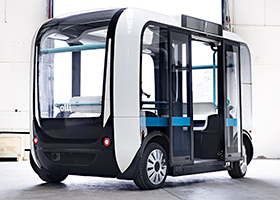A self-driving, fossil-free bus. This idea might become reality through a forthcoming collaborative project involving the Swedish National Road and Transport Research Institute (VTI), Linköping University and several other participants. The project group aims to have the self-driving bus in operation in Linköping, Sweden, for a 12-month trial period, starting towards the end of 2018.
Trials of self-driving smaller buses have been carried out in several cities around the world over the last few years. Until now the main focus has been on a technological demonstration of how the buses might function, and to a lesser extent on how they affect and benefit those who are expected to use the buses.

The selfdriving bus “Ollie”.
Photo: Autonomous Mobility
– This type of transport solution provides great opportunities for society and the individual, but at the same time there is great uncertainty about what would be required to make them really useful, says Anna Anund, Head of Research at VTI.
– Because of this there is a particular need for research capable of yielding knowledge quickly and of determining the needs of users through practical trials.
Therefore, the aim of the present project is to demonstrate how a self-driving, fossil-free bus can contribute to people’s mobility in a modern, high-density city.
A solution to a concrete transport need
Potential users include residents, university staff, employees of businesses and institutes, as well as visitors to the area. The starting point is that the bus must provide a response to a concrete need for local transport, and be connected to other transport infrastructure such as public transport and car parks in the vicinity. Primarily, the bus is intended for slow progress, between 7-20 km per hour.
The project participants have jointly developed several questions to be answered through different research activities. Subject areas involved include:
• Vehicles – access to charging, road and weather conditions, co-existence with other traffic
• Travellers – adjustment to the individual, safety and security, speech and gesture control
• Road and traffic environment – navigability, design of bus stops, flexible bus stops
• Operation – traffic management and control, rescheduling
• Society – route design, sustainability, health, utilisation
• Business models – financing, principal responsibility, the customer meeting
If all goes according to plan, 2 to 5 self-driving, fossil-free buses will be operating in parts of Linköping for a period of 12 months, starting from the end of 2018.
 Contact:
Contact:
Anna Anund
anna.anund@vti.se
VTI, Sweden
 Anders Lindström
Anders Lindström
anders.lindstrom@vti.se
VTI, Sweden






Follow us: